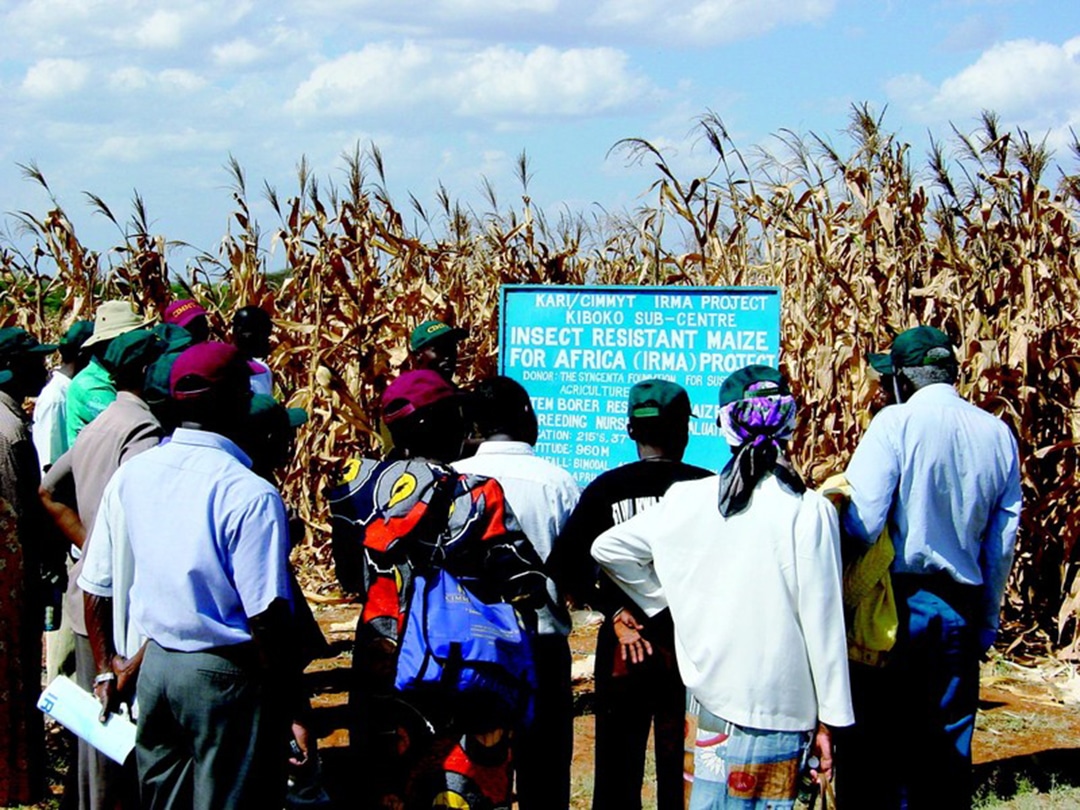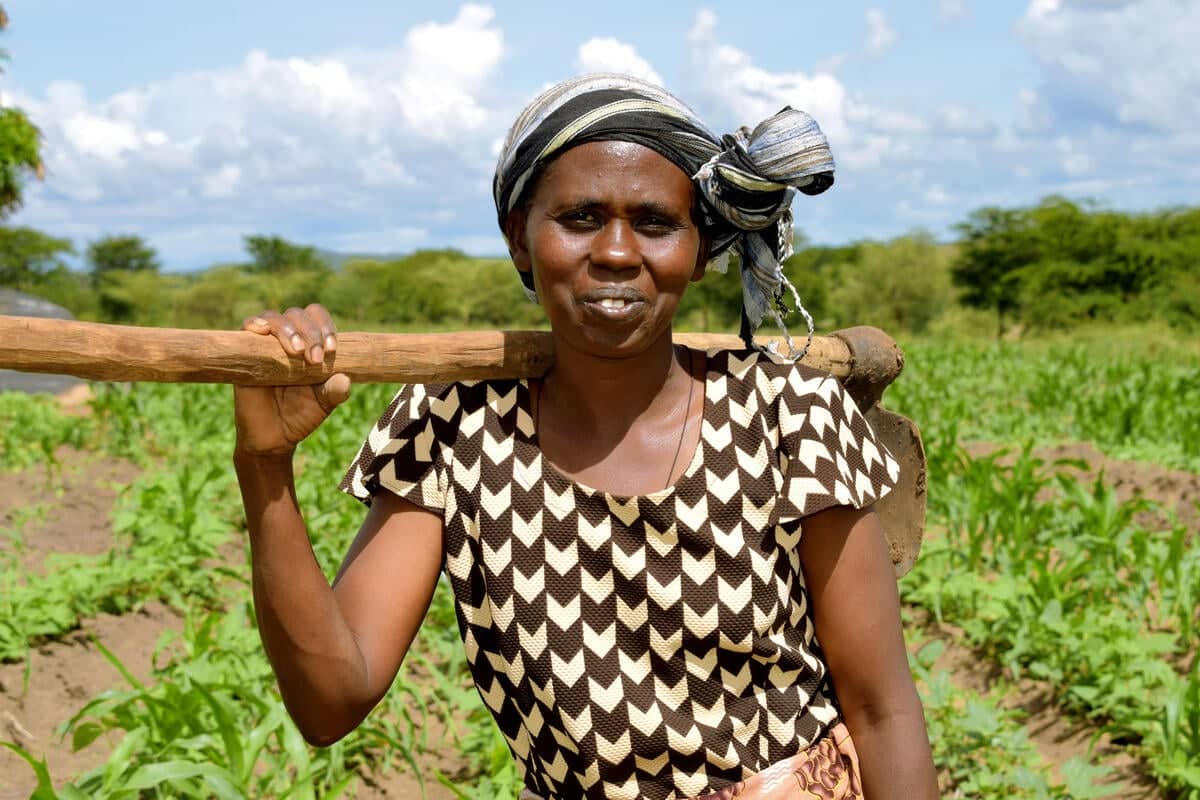

Corporate bioinputs: Agribusiness’s new toxic trap
Up until the end of the 1990s, Monsanto was mainly a company focussed on producing and selling chemical pesticides. These kill bugs quickly and indiscriminately, ideal for large, monoculture farms and routine spraying, albeit devastating for biodiversity and human health. Monsanto didn’t care at all about non-chemical pesticides like those made with the soil microbe Bacillus thuringiensis (Bt). So-called biopesticides, are slower acting and suited to smaller-scale production, with farmers monitoring the crops closely and spraying only when necessary. Though less harmful, biopesticides make much less money for companies, as they usually fall outside the patent industry’s grasp.<
Monsanto’s interest in Bt piqued with the advent of genetic engineering. The company realised it could insert genes from Bt into plants, enabling them to produce the toxin non-stop throughout the plant. This could, in effect, turn the biopesticide into something more akin to a chemical pesticide— well suited to industrial monocropping. And, on top of it, Monsanto could patent this genetically engineered Bt and integrate it into its broader strategy of dominating the seed industry.
Organic farmers, who’d used Bt carefully for generations so as not to encourage insect resistance, knew that if Monsanto moved ahead with its plans, insect resistance would inevitably develop. Two decades later, with multiple species of insects resistant to Bt crops, we know that they were right.[1].
Ironically, Monsanto, bought by Bayer in 2018, is now one of several pesticide companies aggressively trying to take over the global market for biopesticides. From just a handful of companies engaged in the sector a couple of decades ago, there are an estimated 1,200 companies today. Most of these are startups and medium sized companies, but all of the top agrochemical corporations are involved, such as Bayer, BASF, Corteva, FMC, The Mosaic Group, Syngenta, UPL and Yara.[2] They are moving aggressively into the sector in their typical fashion– through buy-ups, licensing agreements and mergers (see Table 1).
Growing corporate interest
Farmers around the world have always invented and used blends of different natural products to protect their crops from insects or to help with the fertility of their soils. It is a practice as old as agriculture itself and the formulas for these “bioinputs” have been passed down through generations. Today, most farmers, especially in the global South, still use bioinputs they produce on their own farms.[3]
!t is only in recent years that agrochemical corporations have started to take interest in bioinputs, or, as they call them, “biologicals”. As the interest of agrochemical corporations in the sector has grown, so has the global market. In 2021, commercial bioinputs’ sales amounted about US$10 billion, which accounts for around 4% of the global agricultural input market. Analysts expect sales to double or even triple by 2028.[4]
A good chunk of the global bioinput market is in fact already in the hands of the top pesticide companies. In 2022, Bayer sold US$214 million worth of bioinputs and it expects sales to reach US$1.6 billion by 2035.[5] Corteva says it sold US$420 million worth in 2023 and the Syngenta Group says it sold US$400 million.[6]
These corporations and their competitors are mainly focussed on biopesticides, which are the biggest sellers, estimated to account for half of the global bioinputs market. The remainder of the market is made up of biofertilisers, which provide nutrients to plants, and biostimulants, which boost the plant’s ability to absorb nutrients.[7] The companies are also fixated on just a few microbes. Bt-based products account for 90% of the global biopesticide market, while 60% of biofungicides contain Trichoderma spp.[8] When it comes to biofertilisers, Cyanobacteria, a blue-green algae with the ability to fix nitrogen and produce growth-promoting vitamins and enzymes, gets most of the attention.[9]
The largest regional market for bioinputs is the US/Canada, followed by Asia-Pacific, Europe and Latin America. Brazil is one of the fastest growing markets, and a major focus of agrochemical companies. By June 2024, 1,273 agricultural bioinputs were registered for sale in the country, half of them for biopesticides and half for biofertilisers, and the vast majority for use on Brazil’s top monoculture crops– soybeans, maize and wheat.[10] Of these products, 82% were made by foreign companies, with Bayer alone accounting for 12%.[11] According to the Brazilian Ministry of agriculture, biofertilisers are currently applied on nearly 40 million hectares, and biopesticides are used on 10 million hectares.[12]
What are bioinputs?
Bioinputs include principally biopesticides, biofertilisers and biostimulants. It is generally agreed that they are all derived from two main sources: biochemical substances and living organisms (microbes and macroorganisms). The most common in the market are microbial bioinputs (using bacteria, fungi and viruses)[13] Subspecies and strains of Bacillus thuringiensis (Bt) are the most widely used, having been commercialised for decades.[14] Another microbe, the Rhizobacteria, has been used in biofertilisers since the nineteenth century.[15] However, there is no standard definition for bioinputs. In Brazil, the legislation defines it loosely as a product, process or technology of plant, animal or microbial origin for use in the production, storage and processing of agricultural products, aquatic production systems or planted forests.[16]
A toxic agenda
What’s behind this newfound interest in bioinputs among the agrochemical giants? In the case of biopesticides, a main factor is that they are cheaper and faster to bring to market than chemical pesticides. In the US, the development of a new biopesticide costs between US$3 to US$7 million and can be commercialised in four years, while a chemical pesticide takes three times as long to develop, and can cost more than US$280 million. Increasing bans on toxic pesticides and lawsuits (such as the one over Roundup) are another reason, along with costs along the supply chain that can be lower for biopesticides than for fossil-fuel based agrochemicals. In addition, biological resistance to chemical pesticides is increasing as a result of their massive use in monocultures.[17]
The agrochemical corporations are also interested in integrating bioinputs into their digital platforms, which are increasingly connected with “regenerative agriculture” and “carbon farming” programmes that they offer to farmers and downstream food companies. Bayer, for example, sells biopesticides and biostimulants, but is also moving into the field of fertilisers by investing in engineered nitrogen-fixing bacteria. Bioinputs are integrated in its strategy for regenerative agriculture, carbon farming, gene editing and digital platforms. The “farm of the future” package it plans to sell includes a system where a farmer supposed to do regenerative agriculture uses Bayer’s gene edited maize and soybean. Then, through their digital platform the farmer gets “tailored” recommendations from Microsoft Azure based on historic data. The farmer is supposed to harvest cover crops as low carbon biofuel and to sell carbon credits via the corporations’ carbon programme.[18] The Indian fertiliser company UPL has similar plans through their “Nurture.farm”[19]
But we should not confuse the interest agrochemical corporations now have in bioinputs with any turn away from their toxic chemicals. While farmers have traditionally used bioinputs as an additional strategy to manage pests and diseases, using them sparingly to avoid the development of resistance and the destruction of biodiversity, agrochemical companies want farmers to use their biopesticides in the same manner that they use their chemical pesticides– applying heavy doses in a routine manner as the means of killing any and all bugs. Indeed, for companies like Bayer, bioinputs are complementary to its agrochemical package.[20] In 2016, it developed a ‘toolbox’ that includes both chemical pesticides and biopesticides in a digital platform designed to assess how the products should be combined. Part of the package for farmers participating in the programme are drip irrigation systems, designed by the Israeli company Netafim. It was first marketed in Mexico, where a partnership with PepsiCo was signed, and then expanded to the Mediterranean region, Australia, South Africa, Brazil and Chile, and more recently China and Vietnam.[21]
FMC Corp, one of the largest US-based agrochemical companies, says it will sell bioinputs “in concert” with agrochemicals, and has even developed a Bt biopesticide (Ethos Elite LFR) which includes synthetic insecticide and fungicide.[22]
The same logic applies to biofertilisers. For example, in 2023, Yara launched a biostimulant “to complement” its fertiliser portfolio, and Novonesis recommends the “co-application” of biofertilisers and chemical fertilisers.[23]
And there is another important factor driving agrochemical corporations into the bioinputs market. Advances in gene editing, synthetic biology and data science make it easier for corporations to identify microbes of interest, develop bioinputs from them, and, perhaps most importantly, secure monopoly control through patents (See Box: Monopoly games)[24] The corporations are betting that they will be able to bring these genetically modified products onto market without any regulatory obstacles.
Monopoly games
Between 2000 and 2023, more than 44,000 patent applications for bioinputs have been registered worldwide. Biofertilisers appear to account for two-thirds of the applications, but this figure needs to be nuanced as there is overlap with biopesticides in a significant number of cases. China has led the way by a wide margin, accounting for 80% of all applications. But 97% of the applications in China were exclusively presented at the domestic level, and mostly made by Chinese universities.[25]
The number of patent applications filed in more than one country is a good indicator of the main markets for corporate players. The principal countries where patents are sought for bioinputs are the US, the European Union, China, Australia, Canada, Brazil, Japan, India, Mexico, South Korea, Spain, Argentina, South Africa, Russia and Germany. Bayer is far and away the leader in terms of applications in more than one country. It is followed by a handful of agribusiness giants and a mix of lesser-known agri-tech companies: BASF, Novonesis (former Novozymes), Pivot Bio, Newleaf Symbiotic, Marrone Bio, Valent Biosciences, Locus Agriculture IP Company, Danstar ferment, Syngenta, FMC, Idemitsu Kosan, Spogen Biotech and Sumitomo Chemical.[26]
The corporate rush into the bioinput market could trigger a new wave of life form privatisation, many of which have been used by peasant communities. Patents on processes and genetic sequences of microorganisms will create a corporate-led bioinput market, granting monopoly rights to patent holders. This means that those who wish to use products containing certain patented products or processes must obtain authorisation or pay for their use. This can result in farmers being heavily fined and even imprisoned.[27]
Playing the sorcerer’s apprentice with microbes
The involvement of agrochemical corporations in genetically modifying microbes for bioinputs goes back at least a decade. The Japanese giant Sumitomo Chemical acquired Valent BioSciences, a developer of genetically modified (GM) Bt biopesticides in 2013.[28] Bayer, for its part, has a joint venture with Ginkgo Bioworks, called Joyn Bio, that is developing a nitrogen-producting GM microbe for maize, rice and wheat.[29]

Brazil’s MST (Landless Workers Movement) giving their own bioinput training.
Surfing on different regulations
European deregulation of new GMOs
Last year, the European Commission proposed effectively deregulating “new genomic techniques” (NGT), which would exclude these genetically edited or modified organisms from existing GMO legislation. Currently, GMOs require authorisation to ensure risk assessment for human health and the environment, as well as adherence to labelling and traceability requirements. Despite opposition from NGO’s, scientists, and some farmers’ organisations, the European Parliament voted in favour of deregulating GMOs produced with NTGs[52] While the Parliament supported labelling and detection -seen as a small victory for civil society- these measures rely on declarations from the industry. There is no obligation to publish the methods for detecting and identifying these products.[53] New genomic techniques remain prohibited in organic production. The debate continues, as the Council of Agriculture Ministers has failed to reach an agreement on this deregulation plan, largely due to concerns about patents on NGTs raised by farmers’ organisations.[54]
Agroecology is once again the answer
Industrial agriculture drives the climate crisis and numerous other global issues.[55] These problems won’t be solved by merely reducing pesticides and chemical fertilisers. They stem from the model and scale of industrial agriculture, which is embedded in a predatory and unjust global food system controlled by a few corporations.
| Table 1. Some agrochemical company deals in the bioinput sector | |
| Company | Notes |
| Agbiome (USA) | Monsanto Growth Ventures was its first investor in 2013 (US$17,5 million), followed by the Gates Foundation in 2015 (US$34,5 million). More recently, Agbiome has signed partnerships with The Mosaic Company, BASF and Genective (a joint venture between Limagrain and KWS), and Ginkgo Bioworks just announced its intention of acquiring the company. |
| AgraQuest (USA) | US supplier of biopesticides. Acquired by Bayer in 2012 for US$425 million. Developed Bayer’s number one bioinput, the biofungicide Serenade for fruits and vegetables. |
| Agrivalle (Brazil) | Major seller of bioinputs in Brazil. In 2023, it partnered with Ginkgo Bioworks to improve the biofungicide Agrivalle already sold in the country. |
| Andes (USA) | Since 2021, Bayer and Cavallo Ventures injected US$15 million in this startup to produce biofertilisers. |
| Biagro Group (Argentina) | Acquired by Bayer in 2014. |
| Bioceres (Argentina) | In 2022, Bioceres and the US bioinputs firm Marrone Bio Innovation merged. In 2023, Bioceres and Corteva signed an agreement to commercialise in Europe a biopesticide developed by Bioceres’ subsidiary Pro Farm. |
| BioConsortia (USA) | Has signed agreements since 2020 with The Mosaic Group to develop GE Microbes. |
| De Sangosse Group (France) | In 2024, Bayer signed a new agreement with the UK based company AlphaBio Control (which belongs to De Sangosse Group), for the license of a new biopesticide targeting coleoptera insects in oilseed rape and cereal crops. Bayer has already been distributing another AlphaBio biopesticide for several years. |
| Evogene (Israel) | Since 2019, Corteva has been investing in Lavie Bio Ltd. (Evogene’s subsidiary). In 2023, both signed a partnership to develop biofungicides with AI. |
| Ginkgo Bioworks (USA) | In 2017, Bayer announced a partnership with this company to create a new company that will develop microbials to enhance nitrogen-fixation in plants. In 2022, Bayer signed an agreement with Ginkgo Bioworks to expand its agricultural biologics platform, with a collaboration that will focus on advancing Joyn’s nitrogen fixation program, as well as new programs in areas such as crop protection and carbon sequestration. In 2024, Syngenta announced a new partnership with Ginkgo Bioworks for large-scale bioinput production. |
| Kimitec Group (Spain) | Signed a partnership with UPL in 2022 to commercialise bioinputs in the US. Started in 2023 a partnership with Bayer to commercialise biopesticides and biostimulants. Has subsidiaries in China, North America and Latin America. |
| Lallemand (Canada) | Collaborates since 2017 with BASF and bought in 2024 the corporations’ San Diego-based bioenergy enzymes business. |
| MustGrow Biologics Corp. (Canada) | Has signed partnerships in 2022 and 2023 with Bayer to commercialise biopesticides for banana and potato plantations in Europe, west Asia and Africa. Has also partnerships with Sumitomo Corporation, Janssen PMP, and NexusBioAg, to distribute its bioinputs. |
| Novonesis (former Novozymes, Denmark) | One of the world’s largest producer of enzymes. Signed a partnership in 2012 with Syngenta to develop a biofungicide launched in 2020. Launched the BioAg Alliance with Monsanto in 2013. In 2019, signed partnerships with UPL. Signed a partnership in 2021 with FMC to develop and commercialise enzyme-based biopesticides. |
| Pivot Bio (USA) | Since 2016, has attracted investments from Monsanto Growth Ventures, Temasek, Bunge, Bill Gates, Jeff Bezos, Mark Zuckerberg, among others. |
| Sound Agriculture (USA) | Signed an agreement in 2020 with the Mosaic Group to develop and distribute microbial biofertilisers for soybean and corn in the US, Brazil, Argentina and Canada. In 2021, jointly with Syngenta Ventures and others, Bayer invested US$45 million in this firm for producing a “bio-inspired” fertiliser (not strictly a biofertiliser). |
| Stoller (USA) | Was acquired by Corteva in 2022 for US$1.2 billion. |
| Symbiomics (Brazil) | Signed a partnership with Corteva, and is supported by venture capital managers such as Yield Lab Latam, Vesper, Mov Investimentos, Baraúna Investimentos and Ecoa Capital. |
| Symborg (Spain) | Had agreements with Corteva to distribute biofertlisers in Europe and Israel, and was finally acquired by the corporation in 2022. |
| Data compiled by GRAIN from company and media sources. | |
Subscribe to GRAIN
Notes:




